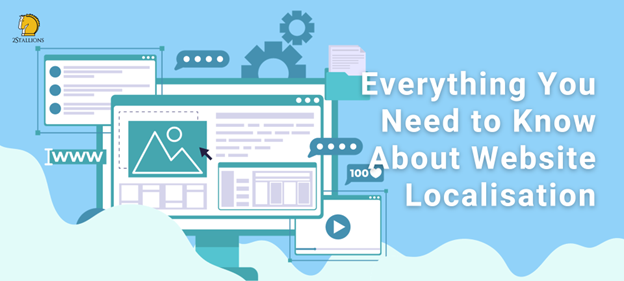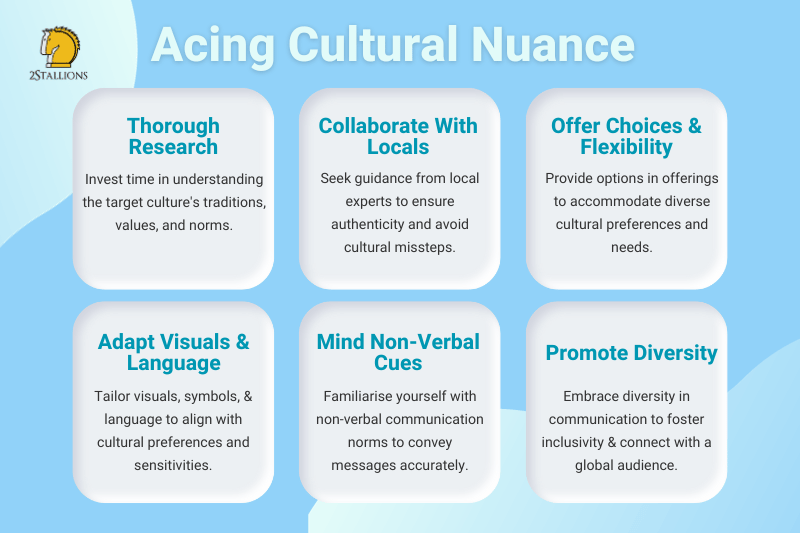Content
SHARE

Are you searching for strategies to improve your company’s regional presence? If so, you want to focus on website localisation to kick things off. If you have a global or regional audience, digital marketing channels, such as your website, social media channels, and email marketing campaigns, help you to reach out to international markets. However, your concerted digital marketing efforts are not bearing fruit in the form of conversions.
The Imperative of Website Localisation
In the contemporary digital landscape, companies face a prevalent challenge when attempting to communicate a singular marketing message to their diverse audience, regionally or globally. This one-size-fits-all approach fails to meet the expectations of today’s digitally savvy consumers. In an era where personalisation is paramount, every digital user seeks a bespoke message that resonates with their unique preferences. This is precisely where the journey of localising your website begins.
[thrive_leads id=’8456′]
As the online population increases, more individuals are joining the digital realm. However, this influx brings a multitude of languages and a preference for consuming information in one’s native tongue. According to a study by Octopus Translations, 55% of consumers worldwide make purchases online only in their native language. Yet, the essence of website localisation transcends multilingual websites. It encompasses a holistic strategy to cultivate your brand identity in each locale, thereby nurturing trust among the local audience. This trust becomes the principle for subsequent growth and success in that region.
Dimensions of Website Localisation: Beyond Multilingual Websites
While translating content into different languages forms a foundational step in website localisation, its true essence lies in a more profound engagement with the target audience. Website localisation process involves:
Linguistic Adaptation:
- Description: Translation of content into the native language is fundamental. It involves not just words but cultural norms, expressions and idioms.
- Importance: Facilitates effective communication by ensuring the audience can comprehend and connect with the content.
Cultural Sensitivity:
- Description: Adapting visuals, symbols, and cultural references to align with local preferences and avoid unintentional cultural missteps.
- Importance: Enhances the user experience by resonating with the cultural norms and values of the target audience.
Technical Adaptation:
- Description: Adjusting technical aspects such as date formats, time zones, and currency to suit local conventions.
- Importance: Creates a seamless and user-friendly experience by presenting information in a familiar and easily understandable format.
Legal and Regulatory Compliance:
- Description: Ensuring the website adheres to local laws, regulations, and compliance standards.
- Importance: Mitigates legal risks and builds trust by demonstrating a commitment to operating within the legal framework of the target region.
User Interface (UI) and User Experience (UX):
- Description: Customise the user interface elements, navigation, and overall design to align with cultural preferences.
- Importance: Optimises user engagement by providing an interface that feels intuitive and culturally relevant.
Localised Content Strategy:
- Description: Developing a content strategy beyond translation, considering cultural nuances and preferences.
- Importance: Drives user engagement by delivering linguistically accurate, culturally resonant, and contextually relevant content.
Multi-Regional SEO Optimisation:
- Description: Optimising website content for search engines in specific regions, considering local search trends and keywords.
- Importance: Improves discoverability by ensuring the website ranks prominently in search results for relevant terms in the target region.
Customer Support and Communication:
- Description: Offering customer support in the local language, providing local contact information, and adapting communication channels.
- Importance: Enhances trust and facilitates effective communication, addressing customer needs in a culturally sensitive manner.
Mobile Responsiveness:
- Description: Ensuring the website is responsive on various devices commonly used in the target region.
- Importance: Optimises the user experience by catering to the local market’s prevalent devices and screen sizes.
Performance Optimisation:
- Description: Optimising website performance, considering factors such as internet speed and device capabilities in the target region.
- Importance: Ensures a seamless and fast-loading experience, particularly in regions with varying levels of internet infrastructure.
In essence, website localisation is a strategic imperative for businesses aiming to thrive in the global digital arena. By acknowledging and addressing the audience’s diverse linguistic and cultural needs, companies can forge meaningful connections, instil trust, and lay the groundwork for enduring success in each targeted locale.
Key Considerations for Website Localisation
Let’s look closer at how you can achieve a localised online experience on your website for your audience. Effective localisation entails the following elements:
1. Branding
How potential customers perceive your brand matters a lot. If your website does not make an immediate impression, they will likely tune out within a few minutes. You may need to revise your branding message or tagline for different regions to connect emotionally with your potential customers and establish your brand identity and awareness. A direct translation may lose meaning or, even worse, turn you into a laughing stock. Here are examples of famous slogans that fell into the direct translation trap:
-
Pepsi. Its slogan, “Come alive with the Pepsi Generation”, is translated into Taiwanese as “Pepsi will bring your ancestors back from the dead.”
Ford. The Ford Pinto failed to break into the Brazilian market. The term “Pinto” is Brazilian slang for “tiny male genitals.”
Mercedes-Benz. The luxury vehicle attempted to enter the Chinese market under the name “Bensi,” which means “Rush to Die.” Later, the company changed its brand name to “Benchi,” meaning “dashing speed.”
2. Cultural Nuances

3. Transactions
eCommerce business sites offering transactions like product purchases or subscriptions should account for transactional elements like currency and payment options. Your website should have an on-site price conversion to assist users in making purchase decisions or, even better, be able to accept the local currency.
Certain countries may have popular payment methods not found elsewhere. Offering local payment methods reduces friction and results in more outstanding sales. For example, in Indonesia, payment processors like Xendit allow people without bank accounts or credit cards to complete transactions offline by paying in cash at over 10,000 retail outlets.
4. Communication
Communication plays a vital role in engaging a local audience. A localised website should include trust elements such as local phone numbers, a local business address and in-language customer support capability. Offering multilingual customer care unlocks sales opportunities. Foreign-speaking customer service representatives break through language barriers, ensuring better customer service and significantly increasing trust in your brand.
Benefits of Website Localisation
-
Increase Brand Credibility
Websites that understand the linguistic and cultural distinctions across regional markets are more likely to receive customer’s trust and respect. As mentioned earlier, in-language content can influence a consumer’s purchase likelihood. This is because when you have a localised website with content in the local language, visitors perceive your brand with more trust.
Product or service information written in the widely-used native language could lead to increased profitable actions like product purchases or lead form submissions. However, do note that you should hire professionals to translate your website. While automatic website translation via something like Google Translate is much more economical, direct translation may lead to miscommunications via inconsistent brand messaging.
-
Effectively Cross Geographical Borders
While English is the most common language, only 20% of the world population or around 1.5 billion people speak it as their first language. Website localisation bridges the language gap and taps into a non-English speaking audience. This leads to increased customer reach within the specific region you are localising for. Over a period of time, this leads to more vital brand awareness in that region, generating increased word-of-mouth and better conversions for your brand.
-
Drive Better Results Online
Website localisation also involves optimising for search engines. Local SEO optimisation means your localised website has a greater chance of ranking on Google within that country for keywords that your global site would find challenging to rank for, as your pages need to be more optimised for the local nuances. For example, in the automotive space, trying to rank in both the US and the UK – both English-speaking countries – is not that simple. See the table below for the nuances between the two. Your UK or US localised website would bridge that gap, allowing you to rank on search engines in both countries.
How Do I Localise My Website?
If you are convinced that you need to localise your website, here are five tips to adapt your website to a specific market:

1. Create Exclusive Content
You should develop exclusive localised content instead of doing a word-for-word translation of your existing website. The best approach would be to consider it a new website when creating content. Use the appropriate terminology, expression, and punctuation that reflects your target audience’s culture and society. This will avoid misleading messages, drive better customer engagement, and increase customer loyalty.
2. Localise Images, Symbols & Colours
You may need to tweak your branding guidelines slightly for different markets. Pay attention to symbols, colours and imagery being utilised on your website. Colours have different meanings in different cultures. For example, green is a traditionally forbidden colour in Indonesia and represents death in South America as it is associated with dense jungles.
In most Western cultures, however, the colour represents luck, nature, and environmental awareness. The same goes for symbols. Hand gestures, for instance, can mean different things in different cultures. In the USA, horn fingers signify approval or “Rock on”, while in Latin countries such as Brazil and Argentina, it is considered an obscene gesture that their spouse is cheating on them.
3. Seek Help from Local Experts
Producing unique content for every market can be time-consuming. Look for local experts who can help with translations and produce unique localised content for you. Individuals who speak the local language and understand the local culture better can help your content become more authentic and allow your brand to resonate better with your target audience.
4. Plan Your Multi-Regional Website Domains
Catering to multilingual audiences means you need to plan for a multi-regional website. You can localise your website domain in several ways to signal to search engines like Google to start ranking you within that country’s search results:
- Country-Code Top-Level Domain (ccTLD):
This two-letter domain extension is fixed to a specific country (i.e. .sg for Singapore and .my for Malaysia). Using this domain name will help users and search engines identify a website as focused on a specific geographic location.
- Generic Top-Level Domain (gTLD):
This generic domain name ends with .com, .net, and .org. Using a geographic sub-domain or sub-directory structure, you can set up geo-targeting for GTLD websites. For example, sg.yourdomain.com or yourdomain.com/sg and then informing Google about that via Webmaster Tools Geographic Target setting.
5. Add A Multilingual Navigation Option
Set up a global navigation system that allows visitors to select their specific localised version of your website. One of the most common designs is a drop-down menu wherein users select their language from a list. You may also use a dedicated landing page that allows users to choose their location or language. You can immediately redirect visitors to a localised version when they enter your global domain by checking their IP address. This further reduces friction, resulting in fewer visitors dropping off.
Conclusion: Go Local If You Can Afford It
Website localisation process can be complex, but it pays off. It will increase the appeal of your website for audiences in your specifically targeted markets and result in better digital conversions – purchases or leads – for your business.
Originally published: 7 April, 2017
Updated: 1 December, 2023
Supercharge your online presence with the Leading SEO Firm in Singapore. Our data-driven strategies guarantee more traffic, more leads, and online success. Contact us now to ignite your digital journey!
Frequently Asked Questions About Website Localisation
”Why
Website localisation is crucial for businesses aiming to expand globally because it involves adapting content, language, and design to suit specific target markets’ preferences and cultural nuances. This ensures the website resonates with local audiences, increasing user engagement, trust, and higher conversion rates.
”What
Website localisation involves overcoming linguistic and cultural differences, technical considerations, and maintaining consistency across multiple languages. To address these challenges, businesses can invest in professional translation services, use localisation tools and platforms, and conduct thorough cultural research to ensure their website effectively appeals to diverse audiences.
”How
SEO strategies for localised websites require careful consideration of region-specific keywords, search engine algorithms, and cultural context. Businesses should conduct thorough keyword research for each target market, implement hreflang tags to signal language and regional targeting to search engines and ensure that the website structure and content are optimised for local search preferences.
”How
Website localisation significantly influences user experience by making content more relevant and accessible to a diverse audience. Businesses should provide clear navigation, culturally appropriate visuals and content, and localised customer support to enhance user experience. Additionally, geotargeting features can further personalise the user experience based on the visitor’s location.

 Pepsi
Pepsi













